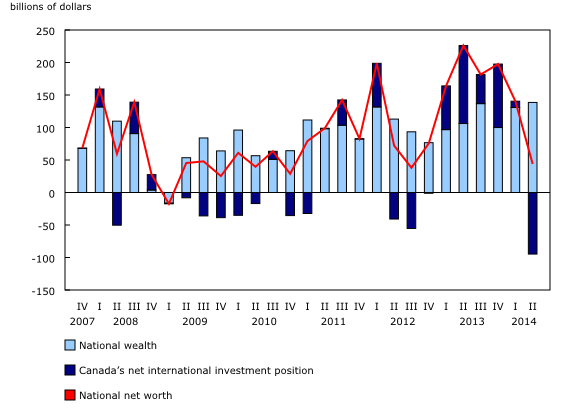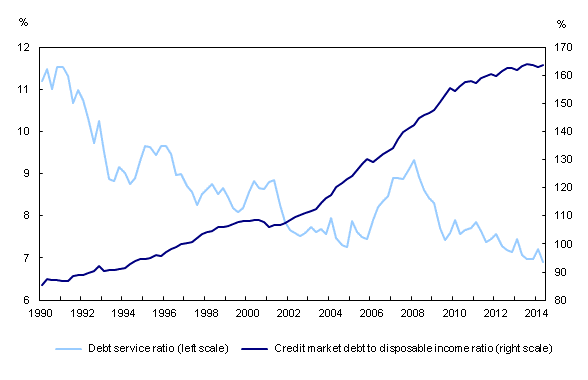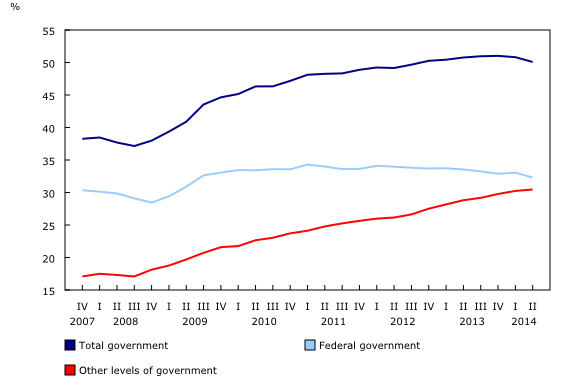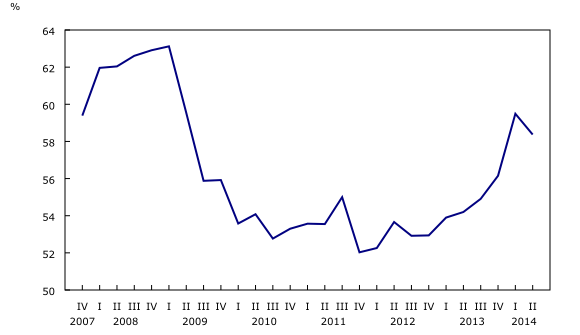National balance sheet and financial flow accounts, second quarter 2014
Archived Content
Information identified as archived is provided for reference, research or recordkeeping purposes. It is not subject to the Government of Canada Web Standards and has not been altered or updated since it was archived. Please "contact us" to request a format other than those available.
Released: 2014-09-12
National net worth edged up 0.6% from the first quarter to $7,907 billion in the second quarter. This was the slowest advance since the third quarter of 2012. On a per capita basis, national net worth edged up to $222,400.
National wealth, or the total value of non-financial assets in the Canadian economy, rose 1.8% to $7,965 billion at the end of the second quarter, led by a $122.0 billion increase in the value of real estate.
The slower growth in net worth was principally due to a decline in Canada's net international investment position, which fell by $94.7 billion in the second quarter, pushing Canada from a net foreign asset position to a net foreign debt position of $57.3 billion. The decline reflected a higher Canadian dollar as well as relatively strong Canadian equity markets, which together increased the value of Canada's liabilities more than the value of its international assets.
Demand for funds by the domestic non-financial sectors (households, non-profit institutions serving households, governments, and non-financial corporations) was $77.6 billion in the second quarter.
Credit market debt (consumer credit, mortgages, non-mortgage loans, short-term paper and bonds) of domestic non-financial sectors reached $4,359 billion at the end of the second quarter. Bonds and debentures and mortgages continued to account for the majority of total outstanding credit market debt.
Household sector
Household net worth advanced 2.3% in the second quarter, led by a gain in the value of household real estate. The increase in household net worth was also supported by continued strength in the value of shares and other equities as well as life insurance and pension assets. On a per capita basis, household net worth rose to $227,000 in the second quarter.
Total credit market debt (consumer credit, mortgage, and non-mortgage loans) stood at $1,797 billion at the end of the second quarter, an increase of 1.3%, which outpaced the growth in disposable income. Consequently, leverage, as measured by household credit market debt to disposable income, edged up to 163.6% in the second quarter but remained below the peak of 164.1% reached in the third quarter of 2013.
At the end of the second quarter, consumer credit debt stood at $513 billion, up $7.1 billion from the first quarter, while mortgage debt rose 1.4% to $1,170 billion.
The household debt service ratio, defined as household mortgage and non-mortgage interest paid as a proportion of disposable income, declined to 6.9% in the second quarter, remaining below the historical average of 8.6%.
The ratio of financial assets to non-financial assets has followed a general upward trend since its marked decline in 2008, when equity prices declined sharply relative to non-financial assets such as real estate. At the end of the second quarter, the ratio stood at 119.2%, nearly unchanged from the previous quarter as both financial and non-financial assets recorded similar rates of growth.
Household owners' equity as a percentage of real estate reached 70.2% at the end of the second quarter, the highest it has been since the first quarter of 2010. The value of household real estate increased at a faster rate than did mortgage debt.
Government sector
Total government gross debt (expressed at book value) increased by $24.8 billion in the second quarter. By the end of the second quarter, the overall government deficit stood at $1.3 billion compared with $9.0 billion in the second quarter of 2013.
Total government borrowing was $26.9 billion in financial markets during the second quarter. Both the federal government and other levels of government were net issuers of short-term paper in the second quarter, a reversal from the net retirements of the previous quarter. Other levels of government also borrowed funds through the sale of bonds and debentures.
The ratio for the federal government net debt (expressed at book value) to gross domestic product declined to 32.3% in the second quarter, while the ratio for other levels of government rose to 30.5%, continuing the upward trend that began in late 2008.
Corporate sector
The financial corporate sector remained a net lender to the rest of the economy in the second quarter. Financial corporate net lending amounted to $10.6 billion over the quarter, while non-financial corporations remained in a small net borrowing position.
Non-financial private corporations borrowed $26.5 billion worth of funds in financial markets during the second quarter. This was largely in the form of bonds and debentures and non-mortgage loans. On a book value basis, the debt-to-equity ratio of non-financial corporations was 58 cents of credit market debt for every dollar of equity at quarter end. While this ratio had been generally declining since the financial crisis, it has trended upward over the last two years.
At the end of the second quarter, financial assets of financial corporations increased 2.1% to $10,554 billion. Domestic equity assets accounted for the largest share of this gain, reflecting a quarter of strong domestic stock prices.
Note to readers
This is a combined release of the National balance sheet accounts and Financial flow accounts. The National balance sheet accounts comprise the balance sheets of all sectors and subsectors of the economy. The main sectors are households, non-profit institutions serving households, financial corporations, non-financial corporations, government, and non-residents. They cover all national non-financial assets and financial asset-liability claims outstanding in all sectors. All data are unadjusted for seasonal variation.
The Financial flow accounts (FFA) articulate net lending or borrowing activity by sector by measuring financial transactions in the economy. The FFA arrive at a measure of net financial investment, which is the difference between transactions in financial assets and liabilities (for example, net purchases of securities less net issuance of securities). The FFA also provide the link between financial and non-financial activity in the economy, which ties estimates of saving and non-financial capital acquisition (for example, investment in new housing) with the underlying financial transactions.
Definitions concerning financial indicators can be found in "Financial indicators from the National Balance Sheet Accounts" and in the System of macroeconomic accounts glossary.
The System of macroeconomic accounts module, accessible from the Browse by key resource module of our website, features an up-to-date portrait of national and provincial economies and their structure.
Links to other releases from the national accounts can be found in the second quarter 2014 issue of Canadian Economic Accounts Quarterly Review, Vol. 13, no. 2 (Catalogue number13-010-X). This publication is available from the Browse by key resource module of our website under Publications. The revised National balance sheet and financial flow accounts for the first quarter have been released, along with those for the second quarter. These data incorporate new and revised source data and updated data.
Data on the National balance sheet and financial flow accounts for the third quarter will be released on December 15.
Contact information
For more information, or to enquire about the concepts, methods or data quality of this release, contact us (toll-free 1-800-263-1136; 514-283-8300; infostats@statcan.gc.ca) or Media Relations (613-951-4636; statcan.mediahotline-ligneinfomedias.statcan@canada.ca).
- Date modified:





